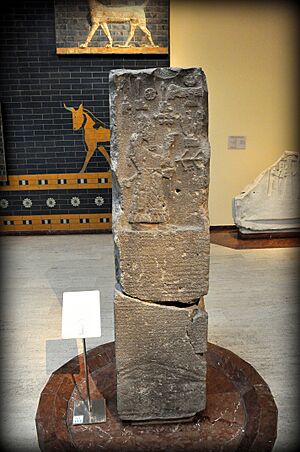Adad-nirari III facts for kids
Quick facts for kids Adad-nīrārī III |
|
|---|---|
| King of Assyria King of the Universe |
|

The Tell al-Rimah Stele was discovered in 1967 and commemorates Adad-nirari III’s campaigns in the West.
|
|
| King of the Neo-Assyrian Empire | |
| Reign | 811–783 BC |
| Predecessor | Shamshi-Adad V |
| Successor | Shalmaneser IV |
| Issue | Ashur-nirari V Shalmaneser IV Ashur-dan III Tiglath-Pileser III? |
| Father | Shamshi-Adad V |
| Mother | Shammuramat |
Adad-nīrārī III (pronounced Ah-dad-nee-rah-ree) was a powerful King of Assyria. His name means "Adad (the storm god) is my help." He ruled the Neo-Assyrian Empire from 811 BC to 783 BC. This was a time when Assyria was one of the strongest empires in the ancient world.
Adad-nīrārī's Family and Early Life
Adad-nīrārī III was the son of Shamshi-Adad V, who was also a king. When his father died, Adad-nīrārī was quite young. Because he was so young, his mother, Shammuramat, played a very important role in the government for the first five years of his rule. Her influence was so great that it even led to the famous legend of Semiramis, a powerful queen.
While some stories say his mother was a regent (meaning she ruled in his place), most historians don't believe that. However, she was still very influential, which was unusual for a queen at that time.
Adad-nīrārī III had several sons who later became kings themselves. These included Ashur-nirari V, Shalmaneser IV, and Ashur-dan III. Another king, Tiglath-Pileser III, claimed to be Adad-nīrārī's son, but we are not completely sure if this is true.
Adad-nīrārī's Reign and Achievements

When Adad-nīrārī III became king, Assyria was facing some challenges. His youth, combined with difficulties his father had faced, meant that Assyria's control over its lands in Mesopotamia had weakened. This allowed some local leaders and governors to become more powerful.
Adad-nīrārī III was determined to make Assyria strong again, just like it was during the time of his grandfather, Shalmaneser III. His own records show that he led many military campaigns to achieve this.
Historical records show that he campaigned in many different directions throughout his 28 years as king, right up until his death in 783 BC. He was also known for building the temple of Nabu, a god of wisdom, in the city of Nineveh.
One of his most important actions was the siege of Damascus in 796 BC. At that time, Damascus was ruled by Ben-Hadad III. Adad-nīrārī's victory greatly weakened the Aramaean Kingdom of Damascus. This allowed the Kingdom of Israel to become stronger under its kings, Jehoash and Jeroboam II. King Jehoash even paid tribute (a payment to show loyalty) to Adad-nīrārī III.
Despite Adad-nīrārī III's efforts to strengthen the empire, Assyria entered a period of weakness after he died. This period lasted for several decades.
See Also
- Calah Slab
- Saba'a Stele
- Shamshi-ilu
- Tell al-Rimah stela


